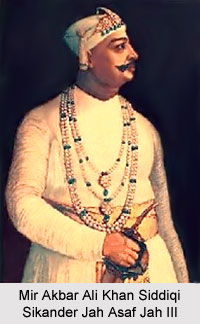 Mir Akbar Ali Khan Siddiqi Sikander Jah Asaf Jah III was the third Nizam of the princely state of Hyderabad, which was the title of the ruler of Hyderabad State in India. He was born 11th November 1768 and ruled over the territory from the year 1803 to 1829. He was the sixth Nizam of the Asaf Jahi dynasty. Asaf Jah III was the 2nd son of Nawab Mir Nizam Ali Khan Siddiqi Bahadur Asaf Jah II and Tahniat Unisa Begum, his wife. Mir Akbar Ali Khan Siddiqi Sikander Jah Asaf Jah III had several other original names such as Asad Jang, Nawab Mir Akbar Ali Khan Siddiqi Bahadur, Asad ud-Daula, Asaf ul Mulk and Sikandar Jah.
Mir Akbar Ali Khan Siddiqi Sikander Jah Asaf Jah III was the third Nizam of the princely state of Hyderabad, which was the title of the ruler of Hyderabad State in India. He was born 11th November 1768 and ruled over the territory from the year 1803 to 1829. He was the sixth Nizam of the Asaf Jahi dynasty. Asaf Jah III was the 2nd son of Nawab Mir Nizam Ali Khan Siddiqi Bahadur Asaf Jah II and Tahniat Unisa Begum, his wife. Mir Akbar Ali Khan Siddiqi Sikander Jah Asaf Jah III had several other original names such as Asad Jang, Nawab Mir Akbar Ali Khan Siddiqi Bahadur, Asad ud-Daula, Asaf ul Mulk and Sikandar Jah.
Rule of Mir Akbar Ali Khan Siddiqi Sikander Jah Asaf Jah III
During the reign of Mir Akbar Ali Khan Siddiqi Sikander Jah Asaf Jah III as the Nizam of the princely state of Hyderabad a British cantonment was set up in the state and the territory was christened and inaugurated after him as Secunderabad. Mir Basheeruddin Ali Khan, also known as Samsamadaula, his son, was the defence adviser to his brother Nasir ud Daula and also to his nephew Afzal ad Dawlah Asaf Jah V Mir Tahniyath Ali Khan Siddiqi. Asaf Jah III did not make any deal or agreement with the British East India Company for sustaining and retaining the British contingent. During his rule, the princely state of Hyderabad faced various financial crisis and administrative problems due to lack of proper management.
Personal Life of Mir Akbar Ali Khan Siddiqi Sikander Jah Asaf Jah III
Mir Akbar Ali Khan Siddiqi Sikander Jah Asaf Jah III was firstly married with Jahan Parwar Begum Sahiba, also renowned as Haji Begum, in May 1800. She was the daughter of Nawab Saif Ul Mulk. His second marriage was with Fazilath Unisa Begum, who was also known as Chandni Begum. The Nizam of the princely state of Hyderabad had nine daughters and ten sons, including-
* Mir Farqunda Ali khan Siddiqi, also known as Naser Ud Daula or Nasir ad Dawlah Mir Farqunda Ali Khan Siddiqi, Asaf Jah IV
* Mir Basheer Uddin Ali Khan Sham Samul Mulk, also known as Samsamad Daula
* Zulfakir ul Mulk Zulfakir ud Daula
* Mir Gawhar Ali Khan, also known as Mubariz Ud Daula
* Saif Ul Mulk Mir Taffazul Ali Khan
* Munawar ud Daula Mir Munawar Ali Khan
* Jahandar Jah Mir Faiyaz Ali Khan Baber Jang
* Qutub ud Daula Mir Mahmud Ali Khan
* Qamar ul Mulk Qamar ud Daula Mir Dilawar Ali Khan Sarwar Jung
* Muzafar Ul Mulk Muzafar ud Daula Mir Fateh Ali Khan Dilear Jung
Shazada Nawab Mir Tafazul Ali Khan Mir Badesha, also known as Saif Ul Mulk, was the only son of Asaf Jah III with his wife Jahan Parwar Begum Sahiba. Mir Akbar Ali Khan Siddiqi Sikander Jah Asaf Jah III died on 21st May 1829 and was succeeded by Nasir ad Dawlah Asaf Jah IV, his eldest son.
Titles of Mir Akbar Ali Khan Siddiqi Sikander Jah Asaf Jah III
The official title and style of Mir Akbar Ali Khan Siddiqi Sikander Jah Asaf Jah III was Asaf Jah III, Nizam ul-Mulk, Nizam ud-Daula, Mir Akbar Ali Khan Siddiqi Bahadur, Fulad Jang, Nizam of Hyderabad.



















